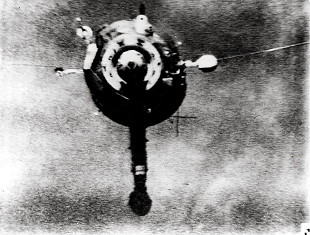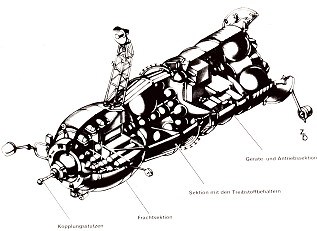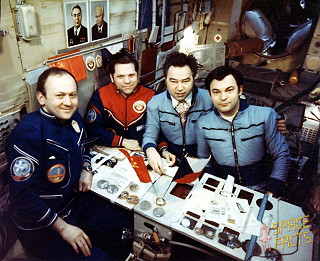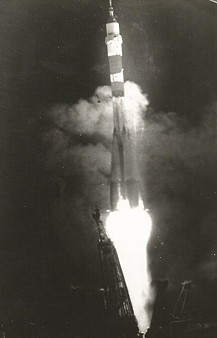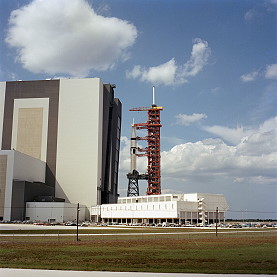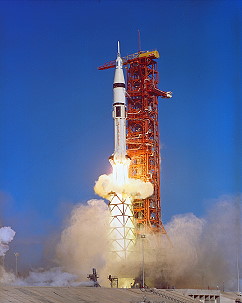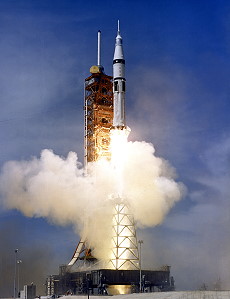I guess I might as well tell you all now.
The Titan IIIL2 has a maximum payload of 35 tonnes to LEO. The modified CSM has a Habitat/Logistics module attached to it's nose that carries up to 10 tonnes of pressurized consumables and equiptment. It's launched with the crew eliminating the need for a dedicated unmanned resupply vehicle.
It is also filled with garbage which burns up in the Earth's atmosphere on Reentry (along with the Service Module while the Command Module lands safely).
The only payload that can safely be brought down is the couple hundred kg that can be recovered with the crew in the CSM.
Unpressurized payloads can also be brought up in a small payload bay in the Service Module. They need to be removed via an EVA. Unpressurized payloads can also be disposed of by a suited astronaut placing them in the Service Module before reentry.
For the design you outline here, 35 tons to orbit seems excessive.
Sure, if we look at Apollo Block II, as used for Lunar missions OTL and presumably here, it looks about right; the CSM, fully loaded on the launch pad, massed 30 tons all up, so you've added a 5 ton mission module, mounted on the nose of the CM, and away we go!
But of course the vast majority of the CSM mass was hypergolic fuel in the SM tanks, needed for the high delta-V Lunar orbit insertion (braking not only its own mass but 15 tons of LM) followed by trans-Earth insertion which is the same delta-V approximately as LOI (but with a much reduced mass) and a reserve of propellant for mid-course corrections and final positioning for reentry. Here, once the Titan has done its job of placing the craft into low Earth orbit, how much maneuvering delta-V can you possibly need? Just a few hundred meters per second, tops. I guess you wouldn't need more than six tons of propellant for the mission--and that assumes that somehow or other the whole craft does mass 35 tons; slim it down and you need even less.
The only contingency I can envision where you need the massive fuel load the Block II SM was filled with is if you plan to use the Apollo, docked to a port on the Skylab, to adjust the Skylab's orbit--presumably to push it up to a higher one after it decays somewhat, or maybe at its end of life, do a controlled deorbit.
Otherwise, it makes no sense to load it up to Lunar mission standards--but then either your orbited mass is going to be a lot less than 35 tons or the Mission Module perched on the nose is going to be one huge mother, dwarfing the CM and perhaps the CSM all up!
Furthermore, while once in orbit this arrangement resembles the ETS Apollo Block III+ and Block IV, with a Mission Module and SM sandwiching the return capsule a la Soyuz, you propose launching it like a Soyuz with its Orbital Module already on top of the crew launch/landing capsule. A drawback of the Soyuz design is that with the OM up there, in case of launch abort the escape tower system has to have the thrust to pull not just the crew capsule but the OM off at a brisk acceleration. This is an annoyance but tolerable with Soyuz design as OTL and ITTL successful crew escapes demonstrate, but that's because the OM is pretty light. Here the Mission Module is quite massive, at least rivaling the mass of the CM, so the launch escape system has to have doubled thrust--and that's if the total mass is way less than 35 tons. Bring it back up to your spec and the abort rocket is mainly pulling the Mission Module with the CM tagging along as an afterthought, even though all that mission mass is being discarded along with the rest of the failed launch.
This is why, of course, e of pi and Workable Goblin had their mission module stashed down below the CSM (and their Block III and subsequent, until the Artemis Lunar Block V, service modules were cut down considerably). After reaching orbit they'd turn around and retrieve the MM just as the LM was pulled out on Lunar missions.
And then they had the drawback to deal with you also adopt--now the MM is stuck on the nose, blocking the pilots in the CM from seeing whatever they are approaching to dock. My suggestion was to adopt a secondary pilot station in the front of the MM, with relay controls and the pilot looking out a window "above" the hatch; they rejected that on mass grounds. (You however have lots of mass to play with so I raise it again.)
It is not clear to me whether the authors here feel they must do things differently than pi/Goblin did out of respect for their having gotten there first, or if you honestly feel these alternatives (Titan, launch with MM on the nose) are either superior or more likely.
I'd propose something else, not necessarily superior to the ETS methods and evolutions but competitive anyway. Suppose instead of shortening the SM, the reduced volume of mission-required fuel and other supplies are shoved to the bottom of the existing module volume, and retaining the same outer skin, the cylindrical volume opened up immediately below the CM becomes the pressurized Mission Module section, accessed by a hatch in the CM heat shield? There all your supplies, including those that in your version are stored in vacuum and require a spacewalk to retrieve, are racked right there. The ship docks to the station just as earlier Apollos did, nose-on with the pilots having a clear view, and then supplies are hauled through the CM.
Now of course the escape system only has to lift the CM itself, as per prior Apollo and Mercury practice. The Titan launcher probably won't make a much bigger bang than the Saturn IB would if it blew up--well it might, since the hypergolic fuels are sure to react with each other if they meet whereas the IB's first stage kerosene and oxygen need a spark and perpetuated flame to do so--OTOH the hypergolic reaction might initially be so violent that it throws the bulk of both propellant components apart from each other, leaving them to do their corrosive and poisonous evil separately. I say a Titan launch failure is clearly a much worse thing for the people on the ground than a Saturn IB blowup, clearly. But the relevant thing for the crew in the spaceship is getting out ahead of the blast and fireball, and for that the two might be equivalent. In the worse case, where the propellants do mix and react with each other pretty much entirely, I suppose the blast from the Titan would be worse, therefore the escape system for Titan-launched Apollos must be more powerful. This underscores the need not to burden it with unnecessary mass, hence the Mission Module should not be where you have it, prepositioned on the nose at launch, but stashed away below somewhere, to be skewered after reaching orbit a la pi/Goblin's Block III+ or kept below via a hatch as I am suggesting.
The Apollo Command Module used Hypergolic rocket fuels, so no boil off for fuel...
That's "Service Module," a separate capsule from the CM--though the CM also had its own reserve of hypergolic fuels for the attitude control thrusters built into it. Which by the way leaked during the return from the final Apollo mission, the Apollo-Soyuz docking mission of 1975, with unpleasant consequences for the crew.
Since I'm suggesting putting the crewed Mission section down below, a la TKS and Big Gemini, that puts the crew in direct proximity to the fuel tanks. So once again I will put in a brief plea for an alternative propellant--kerosene-peroxide, which can have ISP comparable to the pressure-fed hypergolic main Service Module engine. Hydrogen peroxide is certainly not totally innocuous; it would be a disaster to have it spraying into the inhabited section of the SM, and worse if kerosene also got added to the mix. But far more survivable than the same thing happening with hypergolics!

Also, one can use peroxide for backup purposes--it can be a source of water, of breathing oxygen, and serve other purposes. For instance driving a power generator turbine. It is just as storable as the hypergolic fuels, as is kerosene, which would have a much smaller mass than the peroxide--just 1/7, due to the chemistry of the reaction. So one is mainly storing HTHP, which is quite dense, with the kerosene as almost an afterthought.
